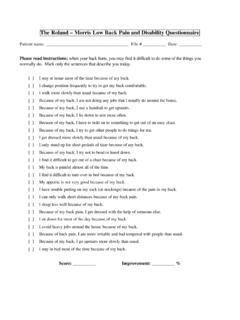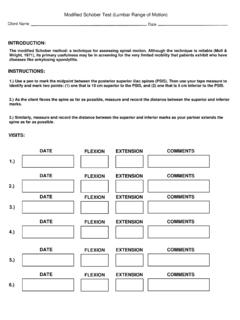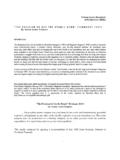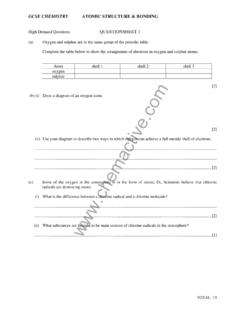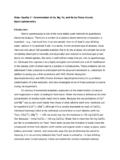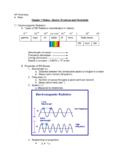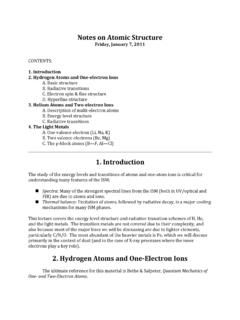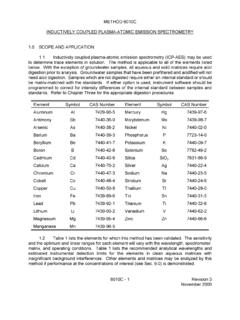Transcription of Research Methods Knowledge Base - Anatomy Facts
1 Research Methods Knowledge base ContentsNavigatingFoundationsSamplingMea surementDesignAnalysisWrite-UpAppendices Search by William M. Trochim, Cornell UniversityWhat is the Research Methods Knowledge base ?The Research Methods Knowledge base is a comprehensive web-based textbook that addresses all of the topics in a typical introductory undergraduate or graduate course in social Research Methods . It covers the entire Research process including: formulating Research questions; sampling (probability and nonprobability); measurement (surveys, scaling, qualitative, unobtrusive); Research design (experimental and quasi-experimental); data analysis; and, writing the Research paper. It also addresses the major theoretical and philosophical underpinnings of Research including: the idea of validity in Research ; reliability of measures; and ethics.
2 The Knowledge base was designed to be different from the many typical commercially-available Research Methods texts. It uses an informal, conversational style to engage both the newcomer and the more experienced student of Research . It is a fully hyperlinked text that can be integrated easily into an existing course structure or used as a sourcebook for the experienced researcher who simply wants to browse.[Back to Top]PurchasingYou can purchase a complete printed copy of the Research Methods Knowledge base over the web by selecting the link Purchase the complete printed text of the Knowledge base online at the bottom of any page. [Back to Top]Using the KB in a CourseAs of August 1, 2000, all course and classroom support for the Knowledge base is being handled by my new publisher, Atomic Dog Publishing.
3 You can reach them at their website at In addition to providing a unique online version of the Knowledge base text, they are the exclusive publishers of the print version. Through Atomic Dog Publishing you can expect the finest in web-based course support for the Knowledge base including workbooks, study guides, online testing, test item data banks, and much more. If you have any questions about use of the Knowledge base in your course, please check their website or contact them directly by e-mail at - What is the KB?- Purchase- Citing the KB- Using the KB in a Course- Copyright Information- About the Author- Acknowledgements- (1 of 2) [7/21/2002 1:29:54] Research Methods Knowledge the AuthorWilliam Trochim is a Professor in the Department of Policy Analysis and Management at Cornell University.
4 He has taught both the undergraduate and graduate required courses in applied social Research Methods since joining the faculty at Cornell in 1980. He received his in 1980 from the program in Methodology and Evaluation Research of the Department of Psychology at Northwestern University. His Research interests include the theory and practice of Research , conceptualization Methods (including concept mapping and pattern matching), strategic and operational planning Methods , performance management and measurement, and change management. He is the developer of The Concept System and founder of Concept Systems Incorporated. he lives in Ithaca, New York with his wife Mary and daughter Nora. [Back to Top]AcknowledgementsThis work, as is true for all significant efforts in life, is a collaborative achievement.
5 I want to thank especially the students and friends who assisted and supported me in various ways over the years. I especially want to thank Dominic Cirillo who has labored tirelessly over several years on both the web and printed versions of the Knowledge base and without whom I simply would not have survived. There are also the many graduate Teaching Assistants who helped make the transition to a web-based course and have contributed their efforts and insights to this work and the teaching of Research Methods . And, of course, I want to thank all of the students, both undergraduate and graduate, who participated in my courses over the years and used the Knowledge base in its various incarnations. You have been both my challenge and inspiration.
6 [Back to Top] New locationDedicationFor Mary and Nora who continue to astonish me with their resilience, patience, and love[Back to Top] Copyright 2002, William Trochim, All Rights ReservedPurchase a printed copy of the Research Methods Knowledge (2 of 2) [7/21/2002 1:29:54]Contents [ Home ] [ Contents ] [ Navigating ] [ Foundations ] [ Sampling ] [ Measurement ] [ Design ] [ Analysis ] [ Write-Up ] [ Appendices ] [ Search ] Research Methods Knowledge BaseContentsNavigatingYin-Yang MapThe Road MapFoundationsLanguage Of ResearchFive Big WordsTypes of QuestionsTime in ResearchTypes of RelationshipsVariablesHypothesesTypes of DataUnit of AnalysisTwo Research FallaciesPhilosophy of ResearchStructure of ResearchDeduction & InductionPositivism & Post-PositivismIntroduction to ValidityEthics in ResearchConceptualizingProblem FormulationConcept MappingEvaluation ResearchIntroduction to EvaluationThe Planning-Evaluation CycleAn Evaluation CultureSamplingExternal ValiditySampling TerminologyStatistical Terms in SamplingProbability SamplingNonprobability (1 of 4) [7/21/2002 1:30.]
7 03]ContentsMeasurementConstruct ValidityMeasurement Validity TypesIdea of Construct ValidityConvergent & Discriminant ValidityThreats to Construct ValidityThe Nomological NetworkThe Multitrait-Multimethod MatrixPattern Matching for Construct ValidityReliabilityTrue Score TheoryMeasurement ErrorTheory of ReliabilityTypes of ReliabilityReliability & ValidityLevels of MeasurementSurvey ResearchTypes of SurveysSelecting the Survey MethodConstructing the SurveyTypes Of QuestionsQuestion ContentResponse FormatQuestion WordingQuestion PlacementInterviewsPlus & Minus of Survey MethodsScalingGeneral Issues in ScalingThurstone ScalingLikert ScalingGuttman ScalingQualitative MeasuresThe Qualitative DebateQualitative DataQualitative ApproachesQualitative
8 MethodsQualitative ValidityUnobtrusive (2 of 4) [7/21/2002 1:30:03]ContentsDesignInternal ValidityEstablishing Cause & EffectSingle Group ThreatsRegression to the MeanMultiple-Group ThreatsSocial Interaction ThreatsIntroduction to DesignTypes of DesignsExperimental DesignTwo-Group Experimental DesignsProbabilistic EquivalenceRandom Selection & AssignmentClassifying Experimental DesignsFactorial DesignsFactorial Design VariationsRandomized Block DesignsCovariance DesignsHybrid Experimental DesignsQuasi-Experimental DesignThe Nonequivalent Groups DesignThe Regression-Discontinuity DesignOther Quasi-Experimental DesignsRelationships Among Pre-Post DesignsDesigning Designs for ResearchAdvances in Quasi-ExperimentationAnalysisConclusion ValidityThreats to Conclusion ValidityImproving Conclusion
9 ValidityStatistical PowerData PreparationDescriptive StatisticsCorrelationInferential StatisticsThe t-TestDummy VariablesGeneral Linear ModelPosttest-Only AnalysisFactorial Design AnalysisRandomized Block AnalysisAnalysis of CovarianceNonequivalent Groups AnalysisRegression-Discontinuity AnalysisRegression Point Displacement (3 of 4) [7/21/2002 1:30:03]ContentsWrite-UpKey ElementsFormattingSample PaperAppendicesCiting the KBOrder the KBCopyright NoticeSearchCopyright 2002, William Trochim, All Rights ReservedPurchase a printed copy of the Research Methods Knowledge (4 of 4) [7/21/2002 1:30:03]Navigating [ Home ] [ Contents ] [ Navigating ] [ Foundations ] [ Sampling ] [ Measurement ] [ Design ] [ Analysis ] [ Write-Up ] [ Appendices ] [ Search ] Yin-Yang MapThe Road Map Navigating the Knowledge BaseThere are at least five options that I can think of for getting to relevant online material in the Knowledge base :The Border ContentsEvery page of the Knowledge base has links in the margins.
10 These links are based on the hierarchical structure of the website and change depending on the position of the page in that structure. The links at the top (repeated at the bottom) on each page show the other pages at the same level of the hierarchy as the page you are looking at. The links in the left border always include:The Home PageThe parent page for the page you are viewingThe child pages for the page you are viewingThe Table of ContentsThis is a standard hierarchical table of contents like the type you would expect in a textbook. It is the only navigational device that at a glance shows every page in the Knowledge Yin-Yang MapThis map is based on a graphic that, at a glance, provides an organizing rubric for the entire Knowledge base content.
